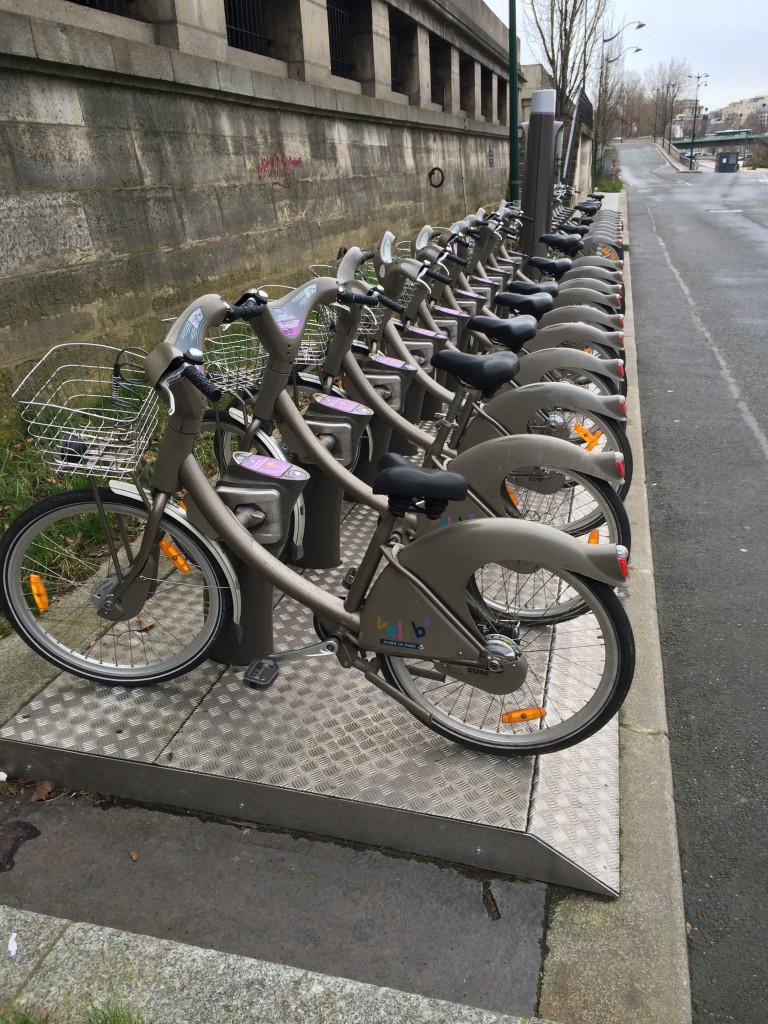
While getting lost, people-watching, and wandering are among my preferred activities in Paris, my singular favourite thing to do has been riding around on the amazing free bikes, the vélibs (vélo = bike and libre = free).
It’s an amazing city for cycling, with many bike paths, and other areas with big lanes for bikes, buses and taxis. This would seem dangerous, particularly in Sydney, but the buses (and cars and taxis) give cyclists a wide berth here.
There are people of all ages, sizes and occupations on the bikes. It’s part of the culture and pace: in warmer weather you might see someone with a baguette in the convenient baskets above the front tire, while they are smoking or talking on a mobile phone with their free hand. It’s even easy to ride at night; the vélibs have bright lights, powered by the cycling, and it’s all very easy.
Most people wear neither helmets nor fluoro safety vests, a sign to me of cycling’s relative safety – as is the fact that people cycle in all weather. The rain is never very heavy and usually stops but I’ve still been surprised how many people ride when it’s raining. It seems the sturdy fenders prevent one from getting splattered. Now, in the cold, people are still riding, just wearing heavier versions of their stylish scarves.
There is a certain technique for choosing one’s bike. I notice that the native Parisians kick at the tires to see if they’re flat or not. But they must have more sensitive toes than my own can’t tell the difference between tires that are fully pumped and a little deflated – I give them a squeeze with my thumb and forefinger. One also should give the pedals a quick spin to see that they move smoothly, that the seat can be adjusted but stays tight (so that going over a bump, the seat does not suddenly drop six inches), and that the rubber grips aren’t missing (in colder weather, the bare metal is rather uncomfortable).
There is a sort of organised chaos. Most cyclists pay attention to road rules, but some do not. Most pedestrians don’t. At many pedestrian crossings, the cars don’t seem obliged to stop, just to not run over anyone. I’ve seen cars go through red lights, and the drivers give the Gallic shrug, ‘Oops’.
This all adds up to a safer feeling rather than less so, as the majority of people seem laissez-faire about sharing the road or pavement, cycling, or getting somewhere in a hurry (though of course, if someone is blocking your way, you ring your cycle bell or drivers honk).
There are many things I love about my adopted country of Australia, but attitudes to cyclists are perhaps what I love the least. Conservative politicians, colluding with Murdoch-controlled media, have somehow made cycling not a form of exercise or transportation, not a healthy ecological measure or an activity that most people do, but instead a mark of political philosophy and belief. Cyclists are wealthy, annoying, left-wing, lycra-wearing rule-breaking radicals. They must be stopped. It’s so bizarre. I’ve never witnessed another country so rapidly anti-bicycle.

Here in Paris, a yearly membership for a vélib costs only 30 Euros, I sprung for a special card for 40 that gets me a 45 minute free ride at a time, rather than 30 minutes. My handy phone app tells me where to get or leave my bike from, but I also sometimes use it to figure out which way I’m headed! Very occasionally, I’m in a neighbourhood that is super short on bikes, or conversely the stations are too filled to park at. But I’ve found the system incredibly convenient overall.
So, I ride around, energized by the beautiful lines of sight, buildings and views, often singing stupid songs out loud: Do you vélib in life after love? (If Cher vélibed) I’m a véliber (If the Monkeys vélibed). I often get lost, and there are some tricky one-way streets (although there are a surprising number of streets that are one-way but marked clearly that cyclists can go the other way!). But I like getting lost in Paris. I’m not in a hurry and there’s always something wonderful around the corner.
The greatest gift of Paris has been to be here with my partner, and to experience its great joys together. But partners should have time apart too. S. has explored far more of the city than I while I’ve been at work, and knows it better than I do – plus he prefers the slower joys of walking, being a flâneur (as described by Edmund White). The dozens of moments I’ve experienced on a vélib, feeling the wind on my face, caught up in joy and wonder at the city’s beauty and energy, these are the moments I’ve secreted away, the little part of Paris I call my own.

